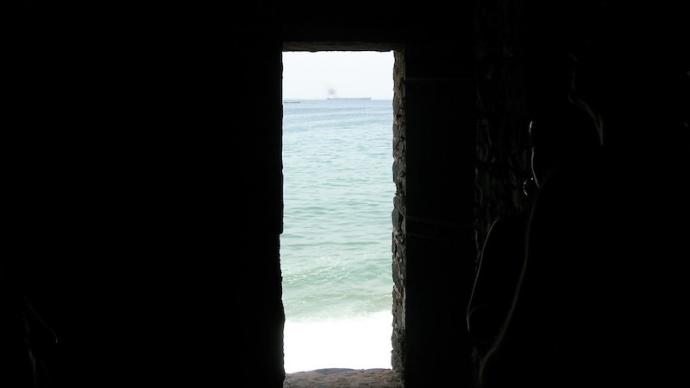
3.5 kilometers off the coast of Dakar, the capital of Senegal in West Africa, there is a small island, the Island of Gorée. The first key word it is known for is the slave trade. From the 15th to the 19th centuries, Goree Island was the stronghold of the European slave trade. There is a "slave house" museum on the island, showing the poor conditions of slaves.
In 1978, Goree Island became a world cultural heritage, showing people "the most painful page in human history". Since then, the island, especially the "Slave House" museum, has become a "pilgrimage place" for Africans from all over the world, and a solemn place for countless people across races to recall and pay tribute to history.
"The transatlantic slave trade was the largest forced human migration in world history. The huge profits from the sale of these forced slaves, depriving them of their labor, laid the economic foundation for Western Europe, the Caribbean and the Americas. And the human cost is the enormous physical and psychological devastation suffered by these enslaved people. Their lives are embedded in every coin that changes hands, added to every spoonful of white sugar stirred into black tea, lost in every sip from The smoke from the pipe is chewed in every mouthful of rice."
- National Museum of African American History and Culture 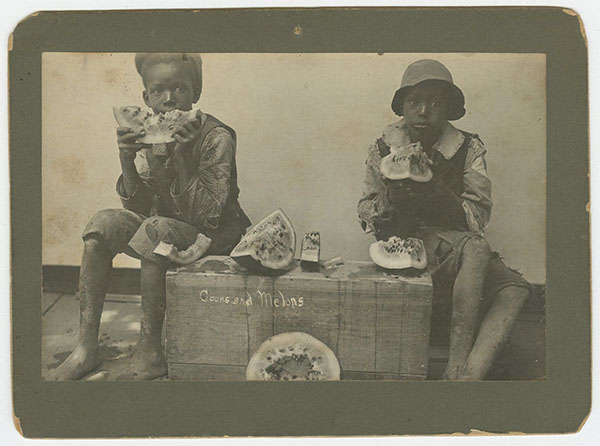
Photo from the collection of the National Museum of African American History and Culture, 19th century, two black men gobbling watermelon. Slavery advocates use this photo to satirize black people's gluttony and laziness. This offensive stereotype still exists today
"Discovering" Goree Island and the Slave Trade
In 1444, Portuguese navigator Dinis Dias became the first European to set foot on the island. Goree Island was uninhabited at the time. Because the island is located in the middle of the north and south ends of the African continent, it is convenient for European explorers to moor their ships, so it has an important strategic position for Europeans. In 1445, Dias discovered the Cape Verde Peninsula, the westernmost point of the African continent, along the Senegal River on the coast of West Africa. But when he attempted to land, he was repelled by the natives and quickly returned to Portugal. 
View of Goree Island from the ferry. Note: The following pictures are taken by the author
His experience was not surprising at the time. Because in the same year he discovered Gore Island, other Portuguese explorers tried to savagely loot the African natives as slaves and traffic them back to Portugal. The explorer Lançarote de Freitas was the initiator. He led an expedition deep into the Senegal River, the first savage abduction of 240 near-shore African natives and brought them back to Portugal. Since then, other expeditions have followed suit. Hundreds of slaves were brought back to Portugal each year. But such looting was quickly met with a pushback from the indigenous peoples. In 1446, the natives in canoes stopped a search of Portuguese ships, prevented them from going ashore, and nearly killed all the marauders. So it's no surprise that when Dias attempted to land, even though he was not involved in the slave trade, his fellow raiders were equally hostile.
Although the European slave trade in Africa started with violence, because of the resistance of the indigenous peoples, the Portuguese quickly realized that this method would not work. Therefore, they adopted "peaceful trade", that is, trade negotiations with local chiefs and merchants in West and Central Africa to buy slaves. For example, in 1456, the Portuguese royal family sent a wealthy businessman Diogo Gomes to West Africa to sign a peaceful trade treaty with the local ruler. At the same time, the wealthy businessman also became "the recipient of all trade goods, including dark-skinned persons, both men and women, and all goods purchased from Guinea, such as spices."
At that time, Portugal coveted both African slaves and West Africa's rich gold resources. An important purpose of their gold was to support their seafaring expeditions. The purchased slaves were mainly sold to the wealthy and nobles of Europe as domestic slaves. By the 1480s, it was still fashionable for the rich to buy black domestic slaves. The Portuguese royal family also made huge profits by granting franchises to wealthy businessmen.
In Africa, the people who sell slaves are leaders or businessmen from different kingdoms or tribes in Africa, who sell prisoners of war or people who have been captured or kidnapped to obtain goods of their own interest. Later, "Islamic societies in North and West Africa were also keen to enslave any non-Muslims." They got novelty goods such as brass, muslin, and glass beads from Portugal and later European countries involved in the slave trade, and, of course, also Including ammunition and weapons.
It should be pointed out that in the 15th century, Africans did not know the word "Africa" and did not consider themselves "Africans" as one. At that time, Africa was composed of many kingdoms or tribes, with extremely diverse social forms, and at the same time, it was also a society with slaves. Before contact with Europeans, West Africa was not isolated from the world, and they had already traded with the North African caravans that crossed the Sahara Desert. They exported gold, kola, spices and slaves, while goods from the north were textiles, salt, pottery, weapons and armor. The trade at this time, although also sold slaves, but the number is small.
In East Africa, the slave trade also existed. In the book "Ancient Red Sea Rim" written at the beginning of the AD, it is recorded that the Arabs not only purchased ivory, rhino horn and other commodities produced in East Africa, but also trafficked a small number of slaves to Asia. There are also sporadic records of Arabs buying and selling slaves in ancient Chinese books of the 9th century.
In addition, the slave trade in the world at that time was not based on the concept of race, but was more a manifestation of social class. Across the wider world, slaves were owned in many places, including Africa, Europe, Asia, and Central and South America. Also, slaves were not necessarily lifelong and may "represent only temporary social classes".
But the great seafaring discoveries of Europeans, which began at the end of the 15th century, changed the nature of slavery. Europeans saw great potential for developing mining and agriculture in the Americas. They mined gold and extended the plantation economy of the Mediterranean and East Atlantic, especially sugar cane, to the Americas. However, because the Native Americans lacked both military advantages and resistance to infectious diseases in Europe and Asia in the face of the sudden arrival of Europeans, and at the same time, the labor intensity of enslavement was very high, resulting in a sharp decline in the population. Therefore, these businessmen set their sights on Africans. At the beginning of the 16th century, the slave trade in the Atlantic Triangle was born.
In this dark trade across the Atlantic, merchant ships sailed from European ports to the coasts of sub-Saharan Africa, exchanging slaves for salt, cloth, weapons, tobacco, rum and beads. After that, the slave traders loaded the slaves into the cabins side by side like cargo, and transported them across the Atlantic to the Americas. Upon arrival, the slaves were either sold in their entirety immediately, or circled for "retail." These merchants exchanged slaves for gold, sugar, coffee, tobacco and rice and other commodities, which became sought-after goods in the market after being shipped to Europe. And the scarce commodities in the eyes of these Europeans are soaked in the blood and tears of African slaves. 
Pots used by black slaves to make sugar after arriving in America. Around the pot are silver products such as teapots and sugar bowls used by people who enjoy sugar. On display at the National Museum of African American History and Culture.
Slavery on American plantations was nothing like slavery or societies with slaves of the past. It is based on racial differences and specifically targets African Americans. Those who were forced into slavery were considered personal property and suffered inhuman treatment. Once a slave, a slave for life, a slave for generations.
In the Atlantic slave trade, which lasted nearly four centuries, some 12.5 million Africans were forced out of Africa and 10.7 million arrived alive. Of these, 97 percent were shipped across the Americas, with the rest going to the West Indies, the rest of Africa and Europe. The top four countries involved in the slave trade were the UK (40%), Portugal (31%), France (18%) and the Netherlands (6%). The countries that dominated the trade varied from period to period: Portugal in the 16th century, the Netherlands in the 17th, and England in the 18th. Other countries involved in the slave trade include Spain, Denmark, Brazil and the United States. In Africa, the regions involved in the slave trade are mainly the coasts of West Africa and Central Africa, and there are also a small amount of regions along the coasts of Southeast Africa.
"Slave House": Condensing suffering, but also the focus of controversy
In this context, the island of Goree has also been controlled by different countries, namely Portugal, the Netherlands, the United Kingdom and France. On this small island, which is 900 meters long and 300 meters wide, there are still buildings from the slave trade and colonial times - "slave houses", churches, forts, forts, etc. 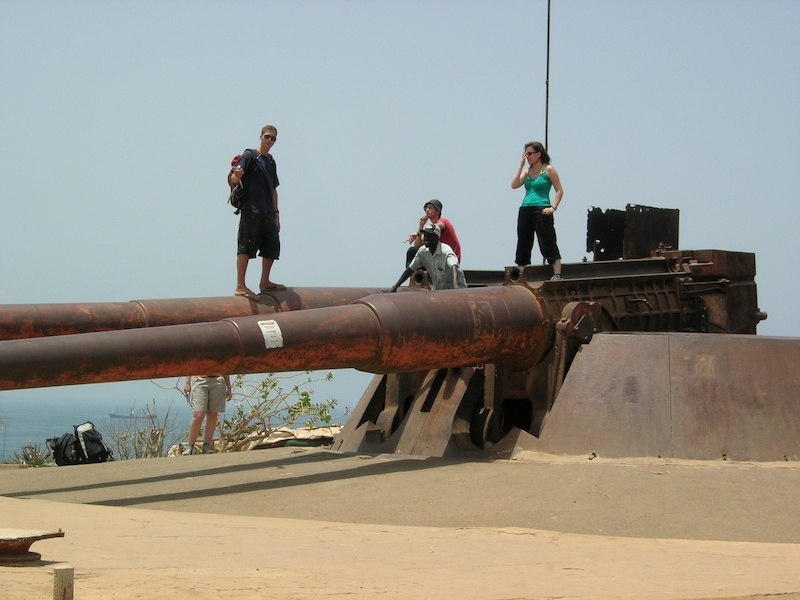
Battery on Goree Island
The buildings on the island are mostly painted in soft and warm colors. Surrounded by tall baobab trees and gorgeous bougainvillea, there are often oil paintings, wood carvings and other works of art created by local artists under the corners and trees. These make the whole island exude a strong romantic and artistic atmosphere. 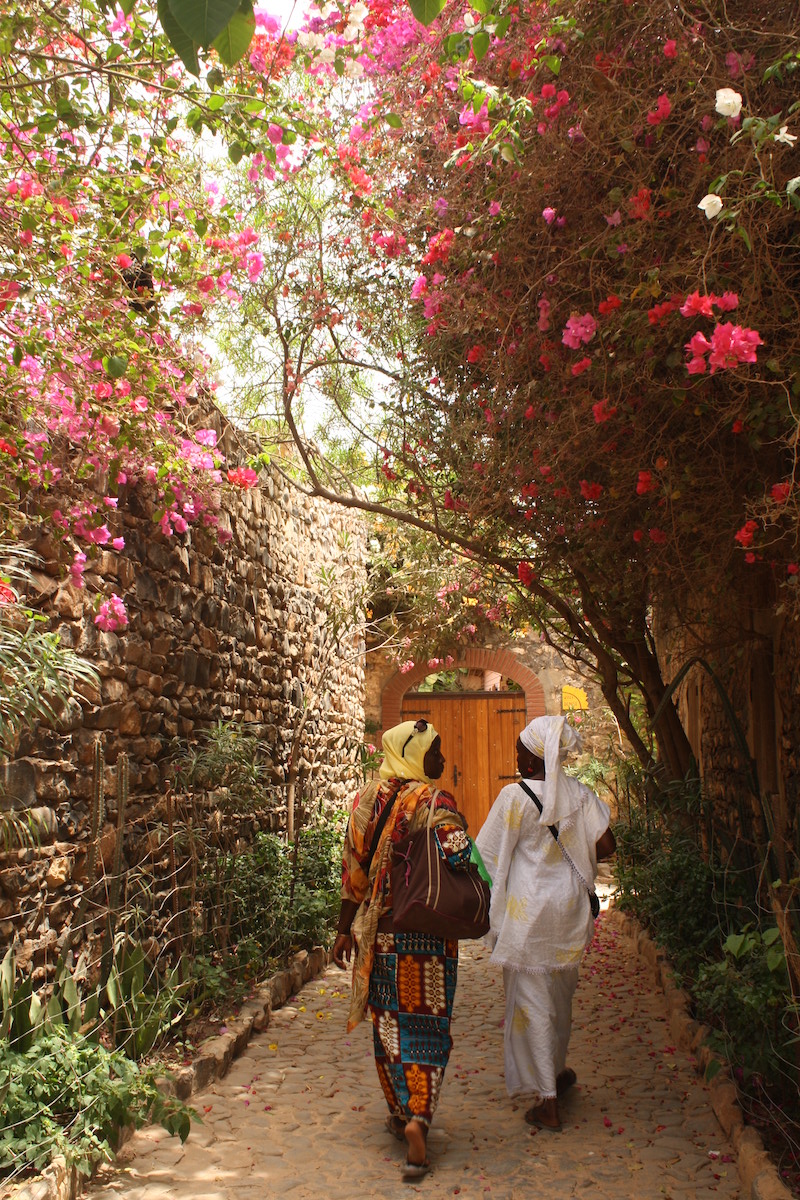
Goree Island Landscape
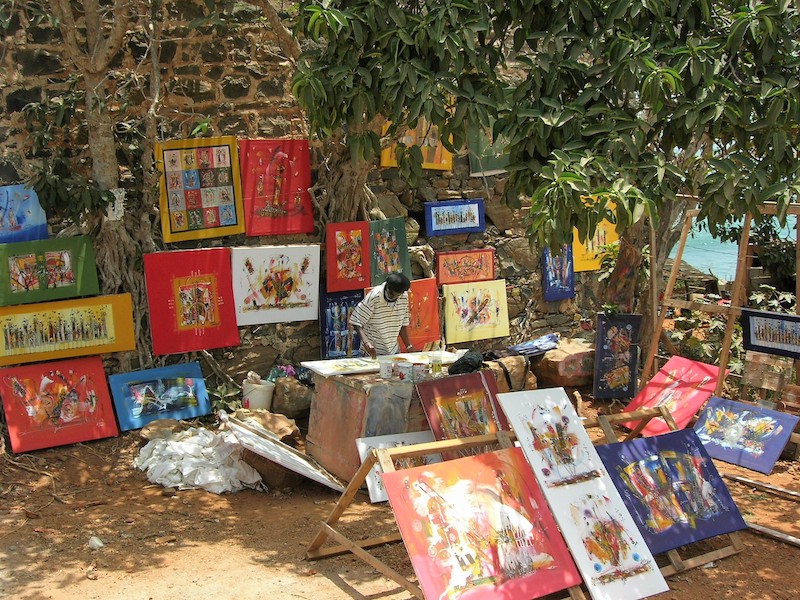
The artist on Goree Island and his paintings
However, every foreign tourist who comes here does not come to see the scenery. The "Slave House" museum is the number one destination for most people. At the entrance of the "Slave House", there is a striking notice board. It reads in French: The Senegalese keep this "slave house" well, the purpose is to remind all Africans that some Africans once left here forever.
This museum is not big, more like a former residence. The house was built between 1776 and 1786, and its original owner was a wealthy non-European woman, Anna Pepin. The building on the second floor has a dark red tone as a whole. Two curved staircases lead to a pillared porch on the second floor. Upstairs, it used to be a spacious and bright residence for slave traders; downstairs, it used to be a dark and crowded cell for slaves. Upstairs, handcuffs, handcuffs and muskets are now displayed; downstairs, it carries the mourning and tears of countless people. 
"Slave House" Museum
Many celebrities have visited here, such as South African statesman Nelson Mandela, Pope Paul II, former US President Bill Clinton, Bush Sr. and Bush Jr., and Obama. Mandela is said to be in tears after visiting the slave cells. Paul II gave a speech while visiting. The speech began with these words: "I heard a cry. I'm here to hear the cry of centuries, generations of Negroes, slaves..." 
Handcuffs and shackles and guns on display at the "Slave House" museum
Henry Louis Gates, Jr., a famous African-American intellectual and Harvard professor who also visited Goray Island, said: "Although I tend to maintain an ironic detachment in this place hollowed out by history, , but to my surprise, when I walked into the room for 'disabled and infirm' slaves, I burst into tears uncontrollably."
Such a location must be reminiscent of the misfortunes suffered by African slaves hundreds of years ago. Once captured and enslaved, everything they experience is a test of the humanity of every person who escorts, sells, transports and enslaves them. Slaves often had to travel long distances to reach the port. This trip was enough to kill many people. Even strong enough to reach the port, they were tossed almost exhausted, filthy, and naked.
Once on board, they will take another six to 12 weeks to cross the Atlantic. And this process is enough to kill another part of the people. They were housed like sardines in the between-deck cabin, which was so limited in height that it was difficult for people to stand upright. The slaves were kept in between-deck cabins most of the time, except for a small amount of time for them to stretch out on deck and bathe in sea water. And it was a group of two who were locked together. The cabin is filthy, with poor ventilation and disease. A Spanish priest named Alonso de Sandoval recorded in 1627: "There was no one in the Spanish crew who kept their head close to the door without getting sick. Stinking, overcrowded, what a miserable place...most slaves arrived skinny."
Some slaves also chose to commit suicide. Thomas Philips, captain of the British slave ship Hannibal, wrote in his journal in 1694: "These Negroes were so headstrong that they did not want to leave their home. Underwater until they drown. They don't want to be taken away, they don't want to be rescued. We've seen some people eaten by sharks. There's a surprising number of sharks near the boat. I've been told that these sharks will Followed the boats all the way to Barbados (located in the eastern Caribbean) because dead slaves were thrown overboard along the way. We had about 12 black people on board who drowned on purpose, and people who went on hunger strike. Because they believed that after they died, , will return to his homeland again, to his friends..."
Female slaves also suffered more painful experiences. They are kept in separate areas where they can move freely. However, it often becomes a tool for the crew to vent their desires.
Riots also occurred on ships, but were mostly brutally suppressed by slave traders. They used muskets and whips against anyone who dared to resist. However, incidents of slaves killing crew members and successful protests also occurred occasionally. But sadly, even if they were freed from the clutches of slave traders, they could not escape the shadow of death. Because they can't sail, what awaits them can only be drifting in the vast sea and starving to death.
The experience of slaves makes people imagine one vague and tragic picture in their minds. But in the slave cells on the first floor of the "Slave House", people "touched" the appearance of that history. Visitors walked into the low and dim room, saw windows the size of "cracks", noticed the mottled rough paint on the walls and the accumulation of tourists' handwriting, and then noticed a pole that could only squat in it. A small dark room, with the words "Confinement Room for Recalcitrants" written above the door... When people saw this, cries and groans instantly entered their ears, and it was difficult to disperse for a long time. 
Mottled walls and narrow windows on the first floor of the 'slave house'
In the face of surging emotions, some people call for reason. Cheikh Sene, a doctor of history at the French Institute of African Studies (l'Institut des mondes africains), once said in an article: Studying the history of the slave trade is not easy, and historians encounter multiple emotional and conceptual difficulties: Taboo, shame, anger, nationalism and belligerence. But we cannot study the slave trade and slavery from an emotional point of view, but from an objective attitude. We have to face the fact that the slave trade was a trade that was legitimized by African rulers and elites on an equal footing with European countries. Some scholars also believe that "an important reason why European countries choose to trade slaves from Africa is that it is easy to obtain the assistance of some local Africans."
Also, there is much debate about the role of Goree Island and "slave houses" in the slave trade. For example, according to the official website of UNESCO, Goree Island was the largest slave trade center on the coast of Africa from the 15th to the 19th century. But in fact, it is very likely not so. In his thesis, Dr. Sheikh Sene said that although there was a slave trade in Gore Island, it was not and never was an important trading center. By contrast, Port Saint-Louis in Senegal was a more active trading post. In addition, the port of Elmina in Ghana also sold a large number of slaves. An article in the American "Archaeology" magazine wrote: Historians estimate that tens of thousands of people left Africa from Goree Island. This number, compared to the scale of the tens of millions of slave trade, is indeed a small part.
Archaeologist Ibrahima Thiaw of the Black Africa Fundamental Research Institute, an important research institution in West Africa, said: "Gore Island was once European, Afro-European, free African and African slaves together. A place to live together. Some slaves on the island are to be sold to the Americas, but more slaves are domestic slaves.” He believed that the slaves owned by the “slave house” were also domestic slaves, not to be sold to the Americas. François G. Richard, an anthropologist at the University of Chicago who has worked with Thio on archaeological research on Goree Island, believes that slave houses would not have been the site of the slave trade. It plays more of a "memorial" role, carrying people's complex emotions about the slave trade.
It is also said that there is a "door of no return" in the "slave house". As soon as a slave leaves this gate, he bids farewell to his homeland. In this regard, some scholars hold different opinions, believing that this is just an ordinary backdoor. 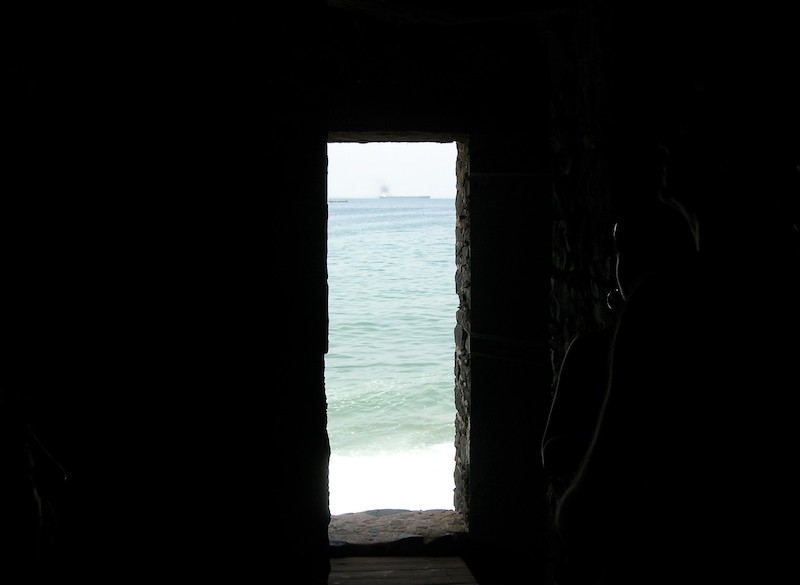
The controversial "door of no return"
But in any case, what scholars generally recognize is that Goree Island and the "slave house" are symbols of the Atlantic slave trade, as the focus of contact between the West and Africans, as a place for mutual dialogue, seeking understanding and forgiveness between different races and cultures. of great significance.
after the slave trade
In the 19th century, the international community gradually abolished the slave trade. The reasons behind this, in addition to economic and political factors, are the huge impetus played by the continuous abolition movement launched by religious groups in North America and the United Kingdom, the signature petitions and public rallies of a large number of people, and the persevering black slave uprisings.
The slave trade was abolished, but its consequences were also profound. For Africa, the loss of large numbers of people has caused massive damage to agricultural production and weakened Africa's economic power. At the same time, looting and wars within Africa to obtain slaves have also planted a long-lasting sense of insecurity in the hearts of the people. The massive slave trade also disrupted the political and social fabric of Africa. Subsequently, Africa suffered from the colonial rule of Western powers, its land was divided up, and its resources were plundered.
The blood and sweat of black Africans in the slave trade "laid the economic foundations of Western Europe, the Caribbean, and the Americas." The enormous value they created changed the face of Europe and shaped the Americas today. And their own lives have been turned upside down: their circumstances in each colony are different, and their natural and social environments are also vastly different; they assess their new identities and create their own culture locally; they rebel against slaves It pursues freedom and power, but it also pays a heavy price for it. Now, when they are free, they also need to deal with the racial prejudice and contradictions that have grown in long-term slavery.
The transatlantic slave trade cast a huge shadow on human morality. But face it, the future can be brighter. Some countries and regions, and even the descendants of slave traders, began to examine themselves or issued a statement of apology. Some of them are from Europe, America, and some from Africa.
Time cannot be turned back, history cannot be assumed. The history of people of different skin colors developing and multiplying alone is gone forever. Therefore, the homework of human beings can only be to think about how to peacefully coexist. Otherwise, the outstretched fist will fall on him at some point.
Standing on Goree Island, overlooking the endless Atlantic Ocean, it is vast and vast. Once upon a time, those who were forced to leave their homeland of Africa must have stared at this same ocean for a long time. The Atlantic Ocean, watching violence and death, listening to cries and weeping, roaring with violent waves pounding the reefs along the shore...